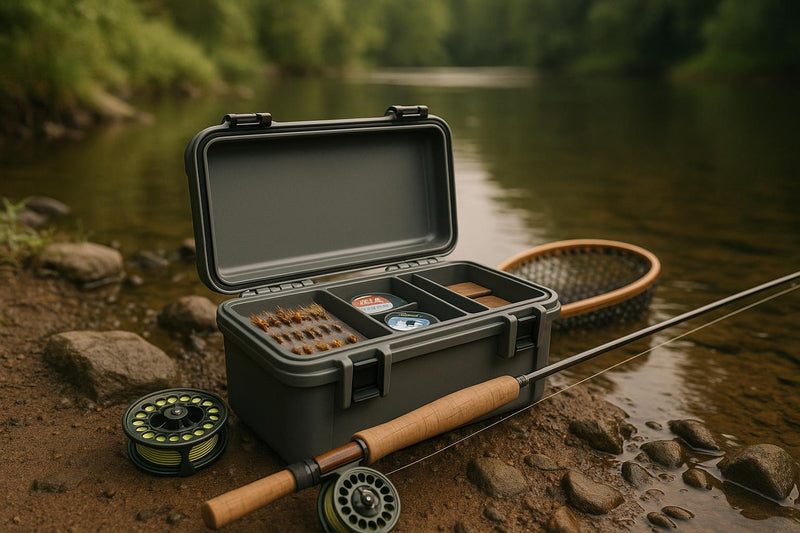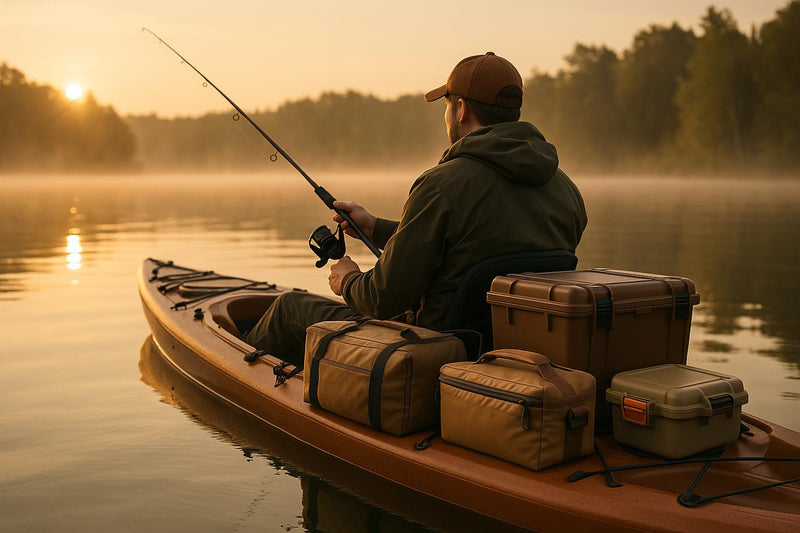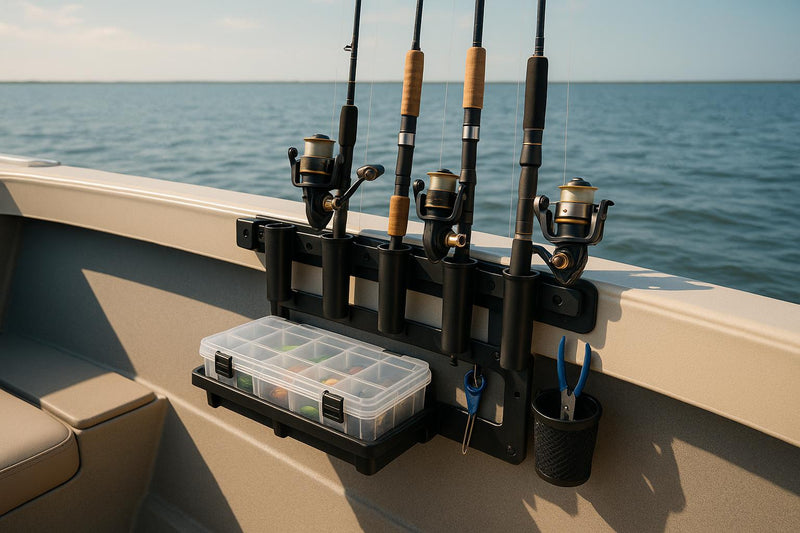Rail storage systems offer a smart way to keep your fishing gear organized, protected, and easily accessible. These systems use mounted rails with customizable attachments like rod holders and tackle organizers, making them a great fit for boats, garages, or sheds. They prevent clutter, reduce equipment damage, and save time during fishing trips. Whether you're outfitting a small boat or creating a wall-mounted setup in your garage, rail systems provide flexibility for your storage needs.
Key Takeaways:
- What They Are: Rails with sliding blocks and attachments to hold rods, tackle, and tools.
- Why Use Them: Organize gear, protect surfaces, and improve safety.
- Types: Boat-mounted (durable for harsh weather) and wall-mounted (modular for indoor use).
-
Popular Products:
- Fish Fighter® SRS Rail System: $67.84–$134.68 for rails, $52.25–$58.66 for blocks.
- Pesca Innovations Modular Rails: $14.95, with rod holders at $44.95.
- Installation: Requires basic tools and marine-grade materials like stainless steel screws and adhesives.
- Customization: Add-ons like drink holders, cutting boards, and tool racks can expand functionality.
- Maintenance: Regular cleaning, inspections, and off-season storage in dry, climate-controlled spaces extend system life.
Rail storage systems simplify fishing by keeping gear within reach while protecting your equipment and boat. Pair them with durable, water-resistant gear for maximum efficiency.
How to Install Rail Storage Systems
Installing rail storage systems can be a straightforward task with the right tools and a clear plan. The process varies depending on your boat's material - fiberglass, aluminum, or otherwise - but following proper steps ensures your system will endure tough conditions and heavy use. Here's how to get started.
Step-by-Step Installation Process
Although the installation process differs slightly based on your boat's construction, the basic steps remain consistent. Before you begin, gather the necessary tools and materials to avoid interruptions.
For fiberglass boats with limited access beneath the gunwales, Traxstech's Track Installation Kit ($30.99) is a useful option. It includes a chamfer tool, a 3/16″ drill bit, and marine-grade adhesive. Be sure to request self-tapping screws (#14, 1-1/4″ length) when ordering the track, as they’re not included in the kit.
Start at the bow when installing tracks on fiberglass. Mark the front holes, drill pilot holes, and insert a couple of screws to temporarily secure the track. Once it’s in place, mark and pre-drill the remaining holes while working toward the transom. After marking all holes, remove the track to chamfer the drilled spots and apply marine-grade adhesive both in and between the holes.
If the fiberglass gunwale has an internal aluminum plate, test-fit screws in all pre-drilled holes to ensure proper alignment. Apply adhesive in each hole and between them before repositioning the track. Use a cordless drill at the recommended torque to secure the screws.
For aluminum boats with limited access under the gunwales, rivets are a reliable alternative. They provide a strong, vibration-resistant hold. Be sure to specify this preference when ordering your track system.
Some accessories, like Forespar's RailFast mounting systems, simplify installation further. These nylon antenna mounts attach to existing rails with an Allen key, making the process quick and easy.
Choosing the Right Mounting Location
Once installed, the effectiveness of your rail storage system depends heavily on its placement. The ideal location should offer easy access while maintaining structural integrity to keep your gear secure, even in rough conditions.
Rail kits allow for flexible mounting, enabling you to add storage spots anywhere on existing cockpit or bow rails. This adaptability lets you customize the setup to suit your boat's layout and your specific needs.
Think creatively when planning your installation. For example, Burnewiin customers have successfully mounted rail systems on side grab handles at the back of pilothouse cabins, utilizing previously unused areas for extra storage.
Modern rail mounts also work well on horizontal rails at vertical stations, providing a secure setup that resists rolling. This design eliminates the need for vertical support locations, giving you more placement options.
Consider your daily activities when deciding on a mounting location. Whether you’re fishing, cruising, or doing a mix of both, the rail system should allow for quick adjustments to accommodate different scenarios. Strategic placement helps prevent clutter and ensures your accessories - like rod holders, downriggers, and cutting boards - are easily accessible.
Additionally, rail mounts can adapt to various rail diameters using shims. Thick shims fit 7/8″ OD rails, thin shims work with 1″ OD rails, and no shims are needed for 1.25″ OD rails. This flexibility ensures compatibility with most rail systems.
Materials and Durability Considerations
Marine environments are harsh, with constant exposure to salt water, UV rays, and temperature changes. Choosing the right materials is crucial for the durability and performance of your rail storage system.
UV-stabilized polymers are an excellent choice for marine rail systems. Unlike standard plastics that can become brittle or discolored, these materials resist sun damage and retain their strength and flexibility over time.
Stainless steel hardware is another must-have. Specifically, marine-grade stainless steel (usually 316 grade) resists corrosion in saltwater environments. While it may cost more upfront, it saves money in the long run by reducing maintenance and replacement needs.
For fiberglass installations, marine-grade adhesives are essential. Products like 3M 5200 create waterproof seals that prevent water intrusion and allow for the natural movement and thermal expansion of the boat.
Just like Fishing shorts or Mens Fishing Shorts are designed to withstand marine conditions, your rail storage system should be made from materials engineered specifically for boat use. Investing in high-quality, marine-grade components ensures your system will perform reliably season after season.
Customizing Rail Storage Systems
Tailor your rail storage system to perfectly suit your fishing style and boat setup with flexible and adaptable options.
Adjustable and Modular Storage Options
Modular rail systems are like building blocks for your boat, allowing you to adjust and expand as your needs evolve. Many of these setups let you swap out components - like replacing rod holders with cutting boards or adding storage compartments - without having to overhaul the entire system.
Adjustable arms and expandable rails make it easy to accommodate different rod sizes and fishing techniques. Most systems include features like spring-loaded mechanisms or thumb screws, so you can tweak the angle and height of rod holders in seconds. This means you can seamlessly switch from trolling in the morning to bottom fishing in the afternoon, all without needing tools.
Track-based systems take customization a step further. These rails act like sliding tracks, letting you position accessories anywhere along their length. For example, if you need to bring your rod holders closer together in a crowded fishing spot, you can simply slide them into place and lock them down.
Another popular option among anglers is the interchangeable insert system. These setups use standardized mounting points so you can start with basic rod holders and later add drink holders, plier racks, or small tackle trays as your needs grow.
DIY Solutions and Modifications
For those who like a hands-on approach, there are plenty of ways to modify rail systems to better fit your fishing habits. Custom foam inserts, PVC modifications, bungee cords, drainage tweaks, and magnetic accessories are just a few ideas.
- Custom foam inserts: Cut marine-grade foam to create inserts that protect expensive rods from scratches and vibration during transport.
- PVC modifications: Craft specialized rod holders by cutting PVC pipes to specific angles and attaching them to existing rail mounts. This allows for precise rod positioning.
- Bungee cord systems: Secure your rods with marine-grade bungee cords stretched between rail points. They provide a flexible restraint that keeps rods safe in rough waters while allowing quick access.
- Drainage improvements: Even if your rail system includes drainage, adding extra holes in strategic spots can prevent water from pooling around your gear. Just make sure to seal the holes with marine-grade sealant to avoid corrosion.
- Magnetic accessories: Attach sealed neodymium magnets to hold metal tools like pliers and knives. This keeps frequently used items within easy reach without taking up storage space.
These DIY tweaks are as practical as customizing your padded fishing shorts for different fishing conditions. A little creativity can go a long way in enhancing your rail system.
Using Interior Rail Systems for More Space
Beyond exterior modifications, interior rail systems can help you declutter your boat while maximizing storage. Installing rails on the inside edges of gunwales, cabin walls, or overhead areas keeps your gear organized and out of the way.
- Pass-through storage: On larger boats with cabin access, rail systems can extend from the cockpit into the cabin, creating a seamless storage solution. This setup is perfect for storing backup rods inside while keeping active rods easily accessible outside.
- Overhead storage: Mounting rail systems to hardtops or cabin overhangs provides a space-saving option for longer rods. These systems often feature spring-loaded holders to secure rods against the overhead surface while ensuring they stay out of the way during normal operations.
- Vertical mounting: For boats with limited horizontal space, vertical rail systems along cabin walls can hold rods upright. Adding padding to these systems helps protect rods during rough conditions. Forward cabins or areas behind seating are ideal spots for these setups.
- Climate-controlled storage: Extending rail systems into enclosed areas allows you to store premium rods and reels in a protected environment, safe from salt spray and UV exposure. Felt-lined holders can add an extra layer of care for delicate equipment.
For the ultimate in versatility, consider combining interior and exterior rail systems. Use exterior rails for active gear and interior rails for backup equipment or items that need extra protection. This dual approach mirrors the functional design of quick-dry, water-resistant fishing shorts, ensuring your gear stays organized and protected no matter the conditions.
sbb-itb-cb0a783
Maintaining Rail Storage Systems
Rinse your rail storage system with fresh water after each trip to wash away salt and other contaminants. This simple step can help prevent corrosion and extend the system's lifespan.
Regular Maintenance Tips
After each use, clean all metal parts with fresh water and a mild detergent. Once cleaned, dry them thoroughly to avoid oxidation. Saltwater can be particularly harsh on metal components, and even stainless steel rail systems require consistent care to maintain their resistance to corrosion. The protective chromium layer in stainless steel can degrade when exposed to chlorides and other contaminants, so frequent cleaning is key to ensuring durability.
Monthly inspections are another critical step. Check all mounting hardware to ensure bolts and screws remain tight, as vibrations from boat movement and wave action can gradually loosen them. Pay extra attention to stress points where the rail connects, and look for signs of rust, corrosion, or metal fatigue.
Be cautious of contamination from iron or carbon steel particles, especially if nearby welding, cutting, or grinding work has been done at marinas. These particles can cause corrosion in stainless steel components. If you notice any metallic dust or debris on your rails, wipe them down promptly.
To keep adjustable components functioning smoothly, apply marine-grade lubricants to sliding tracks, pivot points, and spring-loaded mechanisms. Avoid petroleum-based products, as they can attract dirt and grime. Instead, use silicone sprays or marine grease specifically designed for saltwater environments.
These maintenance routines will also set your system up for successful off-season storage.
Off-Season Storage and Protection
Before storing your rail system for the off-season, follow your regular cleaning and drying routine. Inspect the system for any damage, such as cracks, loose components, or rust, and make necessary repairs.
Store the system in a dry, climate-controlled space like a closet or a storage unit. Maintain the humidity level between 30–50% using desiccants or a dehumidifier.
"A leading off-season guide recommends storing fishing rods vertically on wall-mounted racks in a climate-controlled area with 30–50% humidity to prevent damage".
Protect your rail system from UV exposure by keeping it out of direct sunlight. Elevate the components off concrete floors to avoid moisture from the ground, and ensure proper ventilation around stored items to prevent any buildup of dampness.
During the off-season, periodically check the storage area. Look for signs of moisture, unexpected temperature changes, or pest activity, and address any issues immediately.
Pairing Rail Storage with Functional Gear
A well-maintained rail system works best when paired with gear suited for marine environments. Using marine-grade gear that repels water and dries quickly can make maintenance more efficient.
For instance, Fishing shorts made with water-resistant, quick-dry fabric can keep you comfortable while cleaning or inspecting your rail system. These shorts minimize moisture retention, which is especially important during long days on the water.
Functional storage pockets in your clothing are another plus. They allow you to keep small tools, like screwdrivers, marine lubricant, or cleaning supplies, within easy reach. Mens Fishing Shorts with strategically placed pockets are designed for this purpose, making maintenance tasks quicker and more convenient.
Comfort matters, too. Gear with an ergonomic design that allows for a full range of motion can make maintenance tasks less tiring. The same attention to functionality that goes into designing quality rail systems should extend to the gear you use alongside them.
For more insights, check out how water-resistant gear protects anglers. The principles of moisture management, durability, and quick-drying performance are just as important in your personal equipment as they are in your storage systems.
Key Takeaways
Rail storage systems are a game-changer for fishing boats, offering better organization, improved safety, gear protection, and more deck space. This efficient setup mirrors the practical design principles found in top-tier fishing equipment.
How Rail Storage Enhances Fishing Trips
Rail systems keep your gear secure without eating up valuable deck space - perfect for smaller boats. By reducing clutter, they not only make your boat safer but also protect your equipment from unnecessary wear and tear. Plus, these systems bring a level of convenience to fishing by keeping everything you need within arm’s reach. This is especially handy during fast-paced moments, like sight fishing, where quick access to gear is essential.
What’s more, many rail storage systems are customizable. With track-based designs, you can easily add accessories without the hassle of drilling or using tools. When paired with the right fishing gear, these systems can make your trips even more efficient and enjoyable.
Recommended Gear for Anglers
A well-thought-out rail storage system works best when paired with quality fishing apparel. For instance, water-resistant, quick-drying fishing shorts are a practical choice. They keep you comfortable while giving you the flexibility to move around and access gear with ease. Shorts with functional pockets, like these men's fishing shorts, are especially useful for keeping small tools and supplies handy.
Just like rail systems adapt to different fishing styles, your gear should be equally versatile and durable. Apparel made with quick-dry fabrics and ergonomic designs can significantly improve mobility and comfort, especially on long fishing days. Together, a well-organized rail storage system and thoughtfully chosen gear create a setup that blends functionality with comfort, making every fishing trip more productive and enjoyable.
FAQs
What are the benefits of using rail storage systems for fishing gear?
Rail storage systems provide a practical and streamlined solution for anglers to organize their gear, offering a clear advantage over traditional options like tackle boxes or bags. These systems securely hold rods, reels, and other equipment in place, reducing the risk of damage and eliminating the hassle of rummaging through clutter to find what you need.
They’re particularly handy when transporting gear or managing multiple rods. By keeping everything neatly separated and supported, rail storage systems save time and help protect your equipment. For any fishing enthusiast aiming to simplify their setup and keep their gear in top condition, these systems are a solid choice.
How do I customize a rail storage system to match my boat’s layout and fishing needs?
To tailor a rail storage system for your boat, start by assessing your boat’s layout and the gear you use most often. Consider modular storage solutions that attach to rails or stanchions. These options let you make the most of your space while keeping your gear within easy reach. For example, vertical rod holders and rail-mounted storage bags work well for organizing fishing rods, tools, and other essentials.
Place storage components thoughtfully, taking your fishing habits and the boat’s design into account. Make sure everything is mounted securely, and check regularly for wear and tear - especially if you’re fishing in saltwater conditions. This routine upkeep will help ensure your setup remains safe and dependable every time you’re out on the water.
How can I maintain my rail storage system to ensure it lasts in a marine environment?
To keep your rail storage system functioning well in marine environments, regular maintenance is key. Start by conducting routine inspections to spot corrosion, rust, or wear on any metal parts. Frequent cleaning is also essential to clear away salt, moisture, and debris - common culprits that can speed up deterioration. Applying protective coatings or opting for corrosion-resistant materials can go a long way in reducing rust and increasing the system's durability.
Don't overlook the moving parts. Make sure they’re lubricated on a regular schedule, and replace any components that show signs of wear or damage without delay. These straightforward practices can help safeguard your rail storage system, keeping it dependable and efficient over the long haul.




